
Ken Russell’s large-scale musical, The Boy Friend, started life as a much smaller work. The original idea had been to simply bring Sandy Wilson’s 1954 play to the screen. Russell saw this as an opportunity to take a break from the rigors of such complex and intense productions as The Music Lovers (1970) and The Devils (1971). But Russell—being Russell—found the original too limited and too fragile to bring to the screen when it came down to it, and as a result The Boy Friend became not a film of the play, but a film about a movie director (Vladek Sheybal standing in for Russell as he had done in the 1965 TV filmThe Debussy Film) catching a matinee of the Wilson play being performed by a rundown touring company at an equally rundown theater. In so doing, Russell turned the film into a warm spoof of the classic Hollywood backstage story—an approach that allowed him to turn some of the musical numbers into elaborate fantasies (as envisioned by the visiting filmmaker) in the style of the Busby Berkeley and the Astaire-Rogers films of the 1930s. What had been simple was suddenly complex—and ludicrously underfinanced. The idea of making the film as a kind of working holiday instead turned into one of the most grueling experiences of Russell’s professional life—though neither that nor the lack of budget are anywhere in evidence on the finished film, which emerged as one of the filmmaker’s most captivating and stylish works—and the only one of his films to ever receive a G rating.
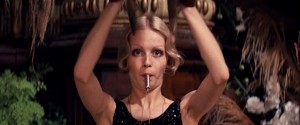
My history with The Boy Friend is convoluted to say the least. I saw the TV trailers when I was in high school, but the film never managed to materialize anywhere near me. Flash forward to the summer of 1975 when I’d just seen Tommy (or more correctly, when I was in he midst of going to see it on a pretty regular basis). Imagine my delight when I found that The Boy Friend was going to be on TV. Then imagine my completey perplexed response when CBS ran a 72 minute version of the film. I had no way of knowing at the time that that was 37 minutes shy of the US print and 63 minutes shorter than Russell’s original version in the UK. In retrospect, it was hardly surprising that I could make very little sense out of what I’d seen.
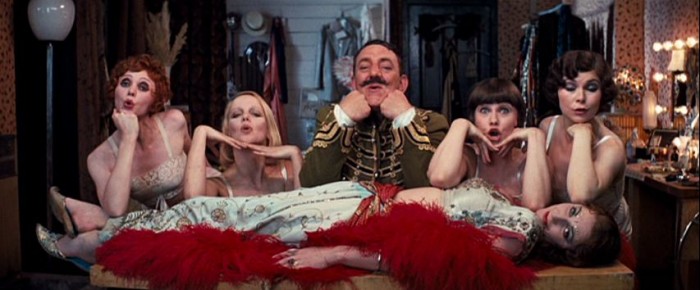
The following year, I caught up with the 109 minute version at a midnight show and—though still shorn of nearly 30 minutes—the story made sense. (The CBS print, it turned out, was not merely severely shortened—some of the scenes had been rearranged.) By this time, I realized that the film had fallen prey to James Aubrey—better known as the Metro-Goldwyn-Mangler—a man who liked to recut movies for no better reason, it seems, than because he had the power to do so. But I wasn’t aware of the extent of the mangling. That came years later when I compared the print at the Library of Congress with a continuity script and learned, for example, that one entire reel had been dropped. The version that we have today is Russell’s own 137-minute version, but it took a long time getting here.
The inspiration for the film’s framing story came from real life. At one point during the early stages of development, Russell attended an amateur production of the play. Word got back to the performers that he was in the audience and they started showing off and playing directly to him in the hopes they’d be discovered and get their big break. Roughly the same thing happens in the film when the cast of the play of The Boy Friend learn that the big movie director—DeThrill—has taken the stage box for the afternoon’s matinee. Certain members of the cast decide to jazz up their roles—or at least their performances. The mirroring between Russell and DeThrill to the very end when DeThrill opts to make something other than a film of the play, since so had Russell.
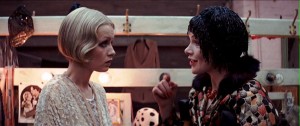
In order to showcase the film’s new star, Twiggy, who (if you need reminding) was at the time the hottest model going, Russell took a page—and even some of the dialgue—from 42nd Street. Twiggy plays Polly (coincidentally the name of the character in the play), the assistant stage manager for the show, who gets pressed into service when the star, Rita (an unbilled Glenda Jackson), breaks her ankle. According to impressario and character actor Max Mandeville (Max Adrian in his final performance), “It’s the assitant stage manager’s job to understudy everybody’s part.” He also claims that he told Polly this when he hired her—which is obviously news to her. The shewdness of this device is that it allows Twiggy—who the film is set to turn into a star—to become a star during the course of the film as her performance onstage (heightened by external forces offstage) becomes better and better as she gains confidence. It really is a film in which a star is born.
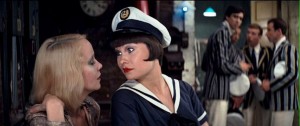
The fact that the film is considered “slight”—in other words, has no particularly deep meaning and is simply intended to be fun—has caused The Boy Friend to be considered a lesser Ken Russell film in a lot of quarters, which is a great pity. It is actually a film of considerable complexity in that it interweaves a great many storylines into its overall fabric. The characters all have considerable depth—or at least the illusion of it—and virtually nothing happens in the film that isn’t ultimately functional to the plot. Even things that seem like complete digressions—Tommy (Tommy Tune) recounting his life story (with a nod to Potemkin in it), for example, are part of an ultimately tight narrative. It’s also interesting that Russell managed to make two of the girls—Fay (Georgina Hale in her second of six Russell appearances) and Maisie (Antonia Ellis in her first of two Russell films)—a lesbian couple in such a way that the MPAA never noticed.
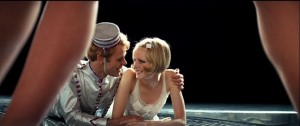
The Boy Friend‘s big claim to fame, of course, are the big production numbers—and I’m not about to fault them. The Busby Berkeley homage of “I Could Be Happy with You” not only manages to capture the spirit of a Berkeley production—drawing heavily from “Young and Healthy” in 42nd Street—but it does it in widescreen and color. And it does it in a way that has its own identity. The recreation of the big “Flying Down to Rio” number from Thornton Freeland’s Flying Down to Rio (1933) not only catches the essence of the original, but does it in such a way that it conveys—very literally—Russell’s own sense of joy in the filmmaking process.
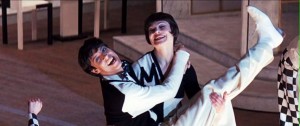
For all the merit to be found in those big fantasy numbers, there is much to be said for some of the film’s simpler productions. There is, for example, an amazing kinetic energy—just in the dizzying way Russell uses the camera—in Maisie and Tommy’s “Won’t You Charleston with Me?” turn that is in some ways even more thrilling than the bigger scenes. It’s hard not to break into applause at its ending. (It should be noted that I’m not speaking broadly when I say the way Russell uses the camera. Most of that number is shot with a hand-held camera meaning Russell—perhaps the greatest hand-held camera operator of all time—actually shot it.)
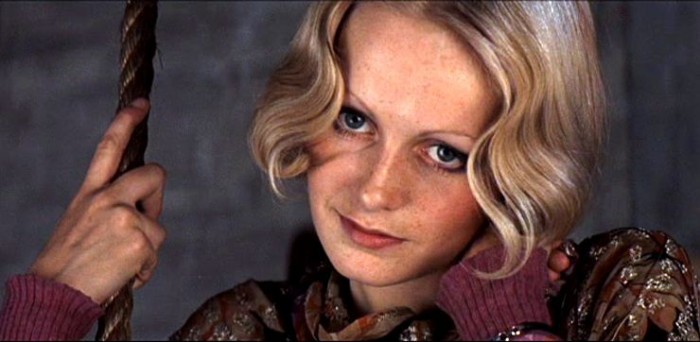
Also, for a big, splashy film, The Boy Friend contains at least two amazing instances of Russell in a quiet, reflective mode. Both are simple scenes of Polly singing. In the first, she sings “You Are My Lucky Star” to a photo of Tony (Christopher Gable in his fifth of seven Russell films). It is the simplest thing in the world, consisting of two shots only—a slow track in on Polly and a zoom out and in on the photo—and yet its charm is incalculable. Even better is a scene where Polly watches Tony dancing on the stage from high above in the flies. Again, it’s essentially two shots—in this case, intercut—but in its own way, it’s as good as anything Russell ever did—and as indelible.
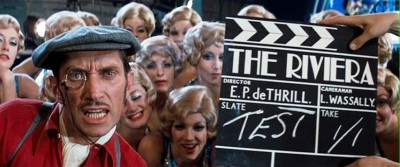
It’s very rarely mentioned, but the film boasts one of Russell’s best screenplays (everything that isn’t Wilson’s play is original material). The dialogue is bright and clever—and surprisingly dense. I doubt that anyone has ever picked up all the jokes in one sitting. At bottom, of course, The Boy Friend is a valentine to old movie musicals—and an often startlingly encyclopedic one. You expect the evocations to things like 42nd Street and Flying Down to Rio, but finding references to the “Lucky Star” number from Warner Bros.’ The Show of Shows (1929) you most certainly do not expect. (Bonus points to anyone reading this who even knows what The Show of Shows is.) Unlike most filmmakers aiming for a nostalgic vibe, Russell worked closely with avant-garde composer Peter Maxwell Davies to get a period sound. Maxwell Davies (who had scored The Devils) wasn’t as odd a choice as it may sound, since his own compositions occasionally contained elements of a period dance band sound, but in any case Russell played him lots of Paul Whiteman, Jack Hylton, etc. to set the idea. The results—with their heavy tuba parts and their use of “gimmick” instruments—had an authentic feel of the late 1920s.
Also rarely mentioned—perhaps because it largely goes unnoticed—is that The Boy Friend for all intents and purposes takes place in real time. The action keeps going even when the film cuts away to something else. The end result—including the lengthening afternoon shadows as the young lovers walk off to get lost in the crowd—makes watching the film convey the sense of having sat through a matinee performance of The Boy Friend. I suspect this isn’t noticed because the fantasy sequences make the time seem to pass in the usual movie sense.
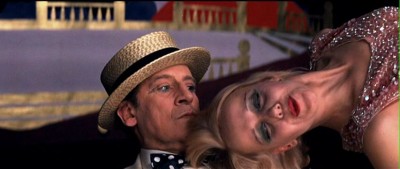
For Ken Russell fans, the film is a particular treat since it contains so many members of what might be called the Ken Russell stock company. Such Russell regulars (or at least repeat performers) as Christopher Gable, Glenda Jackson, Bryan Pringle, Murray Melvin, Georgina Hale, Vladek Sheybal, Antonia Ellis, Graham Armitage, and Catherine Wilmer show up in one capacity or another. But the biggest delight is probably Max Adrian in his swan song. Adrian was ill even at the point of making the film, but he insisted on doing it (Russell has commented that it would have probably killed him not to do it). Even near the end, however, Adrian managed to give us one last increbibly enjoyable performance. Oh, it may not be quite the equal of his Delius in Song of Summer, but it’s the performance a lot of people think of when Adrian’s name is mentioned.
Despite the fact that The Boy Friend is seldom mentioned in the higher rankings of Ken Russell films, there’s nothing minor about it. It really is one of his best films from his richest period. Just sit back and enjoy it.



Before you comment
The comments section is here to provide a platform for civil dialogue on the issues we face together as a local community. Xpress is committed to offering this platform for all voices, but when the tone of the discussion gets nasty or strays off topic, we believe many people choose not to participate. Xpress editors are determined to moderate comments to ensure a constructive interchange is maintained. All comments judged not to be in keeping with the spirit of civil discourse will be removed and repeat violators will be banned. See here for our terms of service. Thank you for being part of this effort to promote respectful discussion.